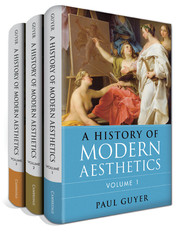Book contents
- Volume 1 The Eighteenth Century
- Frontmatter
- Epigraph
- Contents
- Acknowledgments
- Introduction
- 1 Prologue
- Part One Aesthetics in Britain, 1725–1800
- 2 From Hutcheson to Hume
- 3 Hogarth, Burke, and Gerard
- 4 From Kames to Alison and Stewart
- Part Two French Aesthetics in Mid-Century
- Part Three German Aesthetics between Wolff and Kant
- Part Four Kant and After
- Bibliography
- Index
- Volume 2 The Nineteenth Century
- Volume 3 The Twentieth Century
- References
2 - From Hutcheson to Hume
The Sense of Beauty
from Part One - Aesthetics in Britain, 1725–1800
Published online by Cambridge University Press: 05 June 2015
- Volume 1 The Eighteenth Century
- Frontmatter
- Epigraph
- Contents
- Acknowledgments
- Introduction
- 1 Prologue
- Part One Aesthetics in Britain, 1725–1800
- 2 From Hutcheson to Hume
- 3 Hogarth, Burke, and Gerard
- 4 From Kames to Alison and Stewart
- Part Two French Aesthetics in Mid-Century
- Part Three German Aesthetics between Wolff and Kant
- Part Four Kant and After
- Bibliography
- Index
- Volume 2 The Nineteenth Century
- Volume 3 The Twentieth Century
- References
Summary
In the seminal second decade of the eighteenth century, as we have just seen, responses to Plato’s challenge to the value of aesthetic experience included both the traditional response that such experience does give us access to the true character of reality as well as the new response that aesthetic experience consists in an intrinsically pleasurable and therefore valuable play of the mental powers that is not vulnerable to Plato’s criticism of the cognitive value of the arts, although this play may also have indirect cognitive and moral benefits. Against Plato’s critique of the emotional impact of mimetic art, Du Bos also defended the importance of the experience of the emotions raised by art while distinguishing not the reality but the circumstances of such emotions from those of emotions in real life. In Britain, the traditional cognitivist response to Plato was represented by the Neo-Platonist Shaftesbury, while the idea of aesthetic experience as a form of mental activity enjoyable because of its freedom was introduced by Addison. In the vast literature on aesthetics that was produced in Britain beginning throughout the eighteenth century (even though the German name for the discipline was not nativized until the nineteenth century) the theory that aesthetic experience is an intrinsically pleasurable play of our mental powers accompanied with indirect cognitive and moral benefits predominated, although there were certainly some authors who defended the more traditional emphasis on the cognitive value of aesthetic experience, for example, the Aberdonians George Turnbull and Thomas Reid. The development of this approach to aesthetics went hand in hand with the development of the “moral sense” school of moral philosophy, especially by Francis Hutcheson; David Hume; Henry Home, Lord Kames; and Adam Smith.
- Type
- Chapter
- Information
- A History of Modern Aesthetics , pp. 97 - 139Publisher: Cambridge University PressPrint publication year: 2014



